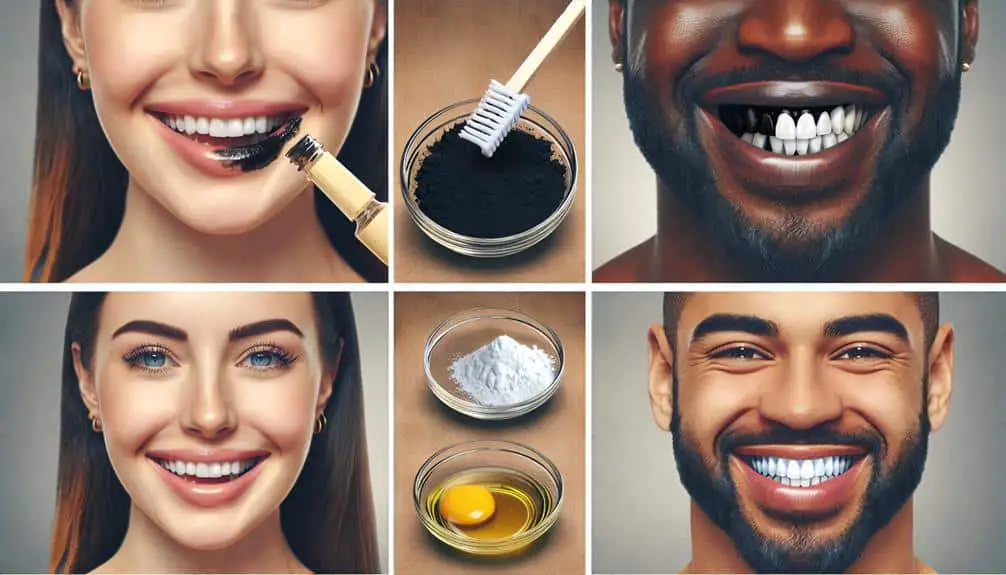Achieve a brighter smile with these proven DIY methods for whiter teeth. Try oil pulling with coconut oil daily, swishing for 15-20 minutes to reduce harmful bacteria and promote healthier gums. Use a baking soda paste 1-2 times a week as a gentle abrasive to remove surface stains and neutralize mouth acids. Activated charcoal products like toothpaste and brushes aid in scrubbing away stains with consistent use. Consider a hydrogen peroxide rinse diluted with water as a mild antiseptic for surface stain removal, and explore the natural exfoliation benefits of a strawberry rub for enamel whitening and gum health.
Key Points
- Oil pulling with coconut oil for 15-20 minutes daily removes harmful bacteria and brightens teeth over time.
- Baking soda paste, a mild abrasive, neutralizes acids and gently removes surface stains when used weekly.
- Activated charcoal products like toothpaste and brushes help scrub away stains with consistent use.
- Hydrogen peroxide rinse, a bleaching agent, removes surface stains when diluted and used in moderation.
- Strawberry rub with malic acid and antioxidants provides gentle exfoliation for whiter teeth and healthier gums.
Oil Pulling
To effectively whiten your teeth using the DIY method of oil pulling, swish a tablespoon of coconut oil in your mouth for 15-20 minutes daily. Coconut oil pulling is a traditional method known for its oral health benefits. The process involves swishing oil around in your mouth to remove bacteria, promote gum health, and potentially whiten teeth. The lauric acid in coconut oil has antimicrobial properties, which may help reduce plaque and fight bacteria that can lead to tooth decay and gum disease.
One of the key benefits of oil pulling with coconut oil is its ability to reduce harmful bacteria in the mouth. Research suggests that oil pulling can notably decrease the levels of Streptococcus mutans, a bacteria known for causing cavities. Additionally, this method can help freshen breath and improve overall oral hygiene. Regular practice of coconut oil pulling may contribute to a brighter smile and healthier gums over time. Remember, consistency is key when incorporating oil pulling into your daily routine for best results.
Baking Soda Paste
For brighter teeth, consider using a baking soda paste as a DIY method to help whiten your smile effectively. Baking soda, or sodium bicarbonate, is a popular ingredient known for its teeth-whitening properties. Its mild abrasive nature helps to remove surface stains on teeth, giving them a brighter appearance. One of the key benefits of using baking soda is its ability to neutralize acids in the mouth, which can contribute to a cleaner and healthier oral environment.
To make a baking soda paste, mix a small amount of baking soda with water to form a paste-like consistency. Gently brush this paste onto your teeth using a toothbrush or your finger. Remember not to scrub too hard to avoid damaging your enamel. After brushing with the baking soda paste, rinse your mouth thoroughly with water.
It's recommended to use this method sparingly, around 1-2 times a week, as excessive use can wear down the enamel over time. Always consult with your dentist before incorporating new DIY methods into your oral care routine.
Activated Charcoal
Activated charcoal, a porous substance known for its adsorptive properties, has gained popularity in oral care for its potential teeth-whitening effects. When used in oral hygiene products like charcoal toothpaste and charcoal toothbrushes, activated charcoal is believed to help remove surface stains on teeth caused by coffee, tea, or wine.
Charcoal toothpaste typically contains a fine black powder of activated charcoal that aids in gently scrubbing away stains. The abrasive nature of charcoal particles helps to polish the teeth and remove plaque, resulting in a brighter smile over time. Charcoal toothbrushes, on the other hand, are infused with activated charcoal in the bristles to provide a continuous whitening effect with regular use.
It's important to note that while activated charcoal can help with surface stains, it may not alter the natural color of your teeth or provide long-lasting whitening effects. As with any teeth-whitening method, consistency is key to seeing results. Remember to consult your dentist before incorporating activated charcoal products into your oral care routine to make certain they're appropriate for your teeth.
Hydrogen Peroxide Rinse
Considering alternative methods for achieving whiter teeth, a common approach that individuals explore is the use of a hydrogen peroxide rinse. Hydrogen peroxide is a mild antiseptic and bleaching agent that can help lighten teeth when used correctly. When diluted with water, hydrogen peroxide can act as a mouthwash to whiten teeth by removing surface stains. However, it's essential to use it in moderation to prevent teeth sensitivity and irritation to gum health.
To create a safe hydrogen peroxide rinse, mix equal parts of water and 3% hydrogen peroxide solution. Swish this mixture around in your mouth for about 30 seconds, being careful not to swallow it. Spit out the rinse and then rinse your mouth thoroughly with plain water. It's recommended to use this rinse no more than once a day to avoid potential side effects like teeth sensitivity and gum irritation.
Strawberry Rub
Wondering how to naturally whiten your teeth? One effective method is the Strawberry Rub, a natural remedy that utilizes fruit exfoliation to help brighten your smile. Here are five key points to keep in mind when utilizing this DIY technique:
- Rich in Malic Acid: Strawberries are packed with malic acid, which is a natural enamel whitener.
- Antioxidant Properties: The antioxidants in strawberries can help remove surface stains on your teeth.
- Gentle Exfoliation: The fruit's texture acts as a gentle exfoliant to scrub away plaque and discoloration.
- Vitamin C Benefits: The vitamin C content in strawberries promotes gum health and fights bacteria in the mouth.
- Fresh Breath: Along with whitening, strawberries can also leave your breath smelling fresh.
Incorporating the Strawberry Rub into your oral care routine can be a fun and effective way to enhance the brightness of your teeth using natural ingredients. Remember to use this method thoughtfully to avoid potential damage to your enamel.
Frequently Asked Questions
Can These DIY Methods for Whiter Teeth Cause Any Harm to the Enamel of the Teeth?
When you use DIY methods for whiter teeth, enamel protection is essential. Some remedies may lead to tooth sensitivity if not done correctly. Prioritize enamel care to prevent harm and maintain a healthy smile.
How Often Should I Use These DIY Methods to See Noticeable Results?
For best results, use DIY methods for whiter teeth 2-3 times a week. Noticeable improvements may be seen in 2-4 weeks. To maintain results, continue for at least 2-3 months. Consistency is key for achieving a brighter smile.
Are There Any Specific Toothbrush or Toothpaste Recommendations to Use in Conjunction With These DIY Methods?
Looking for toothpaste options and toothbrush types to enhance your DIY teeth whitening routine? Consider using whitening toothpaste with fluoride for daily care and a soft-bristle brush to protect enamel while brushing.
Can These DIY Methods Be Used on Sensitive Teeth Without Causing Irritation?
For those with sensitive teeth, managing sensitivity while whitening can be challenging. Natural remedies like baking soda or coconut oil pulling may be gentler options. It's important to consult with a dentist for personalized advice on tooth sensitivity.
Are There Any Potential Side Effects or Risks Associated With Using These DIY Methods for Whiter Teeth?
When using DIY methods for whiter teeth, be cautious of potential risks like enamel damage or gum irritation. Take precautions such as consulting a dentist and following instructions carefully to avoid long-term effects.



